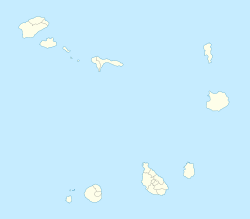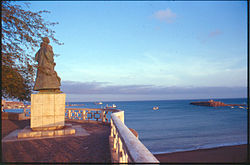
Praia
Did you know...
SOS Children produced this website for schools as well as this video website about Africa. To compare sponsorship charities this is the best sponsorship link.
| Praia | |
|---|---|
| Aerial view of Praia | |
|
|
|
| Coordinates: 14°55′15″N 23°30′30″W Coordinates: 14°55′15″N 23°30′30″W | |
| Country | |
| Municipality | Praia (seat) |
| Elevation | 3 ft (0 m) |
| Population (2008 est.) | |
| • Total | 124,661 |
Praia (pronounced Portuguese pronunciation: [ˈpɾajɐ], meaning "beach", in both Portuguese and Cape Verdean Creole), is the capital and largest city of Cape Verde, an island nation in the Atlantic Ocean west of Senegal. It lies on the southern coast of Santiago island in the Sotavento Islands group. It is the island's ferry port and is home to one of the nation’s three international airports. The city centre is known as Plateau due to its location on a small plateau. Praia is located at 14°55' North, 23°31' West (14.91667, -23.51667).
Praia is Cape Verde’s largest city, a commercial centre, and a port that ships coffee, sugar cane, and tropical fruits. Praia also has a fishing industry and there are resort beaches nearby. It is the seat of the municipality of the same name.
History
The town of Praia de Santa Maria appeared in 1615 when it took the place of the previous settlement on the plateau, which was originally favored because the nearby port (Santa Maria beach) offered good conditions for ships. Initially used as a clandestine harbour (in order to avoid customs fees at the then capital Ribeira Grande), the settlement gradually acquired the characteristics of a town after much of the population from Ribeira Grande fled there during its decline in the midst of frequent pirate attacks. The official transfer of capital status from Ribeira Grande to Praia took place in 1770.
In the history of Cape Verde there have been successive proposals for transferring the capital elsewhere, the most recent being Mindelo in the late 19th century. However, the successive Portuguese administrations never showed an interest (economical or political?) in such proposals. Through an official decree in 1858, when its status was changed from town to city, Praia secured its status as the capital of Cape Verde, concentrating political, religious and economic roles.
During the Portuguese administration, only the central plateau was considered to be the city proper and thus the principal zone of urbanization and concentration of municipal services. It was only after independence that the surrounding neighborhoods generally became accepted as part of the city proper. After independence the city suffered a demographic boom, and after 33 years its population has quadrupled, receiving migrating movements from all the islands. As a result, half of the entire population of Cape Verde currently resides on Santiago; a fourth in the Municipality of Praia; and a fifth in the City of Praia alone.
Geography
Geographically, Praia may be described as a set of plateaus and their surrounding valleys. These plateaus generally have the name achada (Achada de Santo António, Achada de São Filipe, Achada Eugénio Lima, Achada Grande, Achadinha, etc. — achada being a Portuguese word to designate a volcanic plateau), but the central one is colloquially called Plateau (in Portuguese itself). The urban settlement is made mostly on top of these plateaus and along the valleys. The islet of Santa Maria is in front of the beach bearing the same name (today more known as Gamboa).
For a long time, only the Plateau was considered to be the city, being the other neighborhoods relegated to the condition of peripheral suburbs, in spite of always having a close relationship with the Plateau (people movements, goods and services exchanges, etc.). This is why only the Plateau previously had relatively well-developed urbanization with its own infra-structures. The remaining neighborhoods developed in a more organic, chaotic way.
Only after independence did the Plateau merge with the other neighborhoods to constitute what is now considered the City of Praia. The whole city was then equipped with adequate infra-structures and some de-centralization was planned. In spite of being recent, the urban plans are already in progress and the city is expanding north, through Achada de São Filipe, and west through Palmarejo. Although the Plateau is still attracting most of the daily traffic within the city, this is not because it is the largest neighborhood (Achada Grande) nor because it is the most populous (Achada de Santo António), but rather because it is still considered the economic and administrative centre of the city. In spite of de-centralization attempts, the population continues to consider the neighborhoods peripherals to the Plateau, as either "bedroom communities" or industrial zones.
| Climate data for Praia | |||||||||||||
|---|---|---|---|---|---|---|---|---|---|---|---|---|---|
| Month | Jan | Feb | Mar | Apr | May | Jun | Jul | Aug | Sep | Oct | Nov | Dec | Year |
| Source: BBC Weather | |||||||||||||
Demography
The city's population is approximately 124,661, growing from 94,757 in 2000.
| Population of the city of Praia (1990–2005) | ||
|---|---|---|
| 1990 | 2000 | 2005 |
| 61644 | 94161 | 111500 |
Economy
The economy of Praia is dependent above all on the services sector, with some industry as well.
Some industries exist, located on the coast (fishing) or in outlying neighborhoods (rendering of agricultural products, materials for civil construction, etc.)
However, the principal economic activities of Praia belong to the tertiary sector. Beyond activities related to administration and governance (local and national), there are extensive commerce, services (health care, education, tourism, restaurants and hotels, public functions, etc.), and other activities of a liberal character.
With regard to transport, Praia has a network of urban public transport, a seaport and Praia International Airport. The port of Praia is the principal port of exit for products from the island, and the principal port of entry. The airport, with domestic and international destinations, was recently enlarged to allow for long-haul flights.
TACV Cabo Verde, the national airline of Cape Verde, has its headquarters in Praia.
Culture
In cultural terms, the city of Praia is a notable contrast to the rest of the island of Santiago. While the rest of the island, having been first to be inhabited, maintains conservative and traditionalist characteristics, Praia possesses a more cosmopolitan outlook. In its overall culture, Praia has easily absorbed influences from the outer islands due to inter-island migration, as well as influences from abroad due to the concentration of population of foreign origin and the relative ease of communication with other nations. It is easier to find “authentic” cultural elements of Santiago the further one goes from Praia.
Precisely because Praia is the capital, maintains communications facilities with the world, and has the greatest concentration of diversity, it is one of the best places in Cape Verde for cultural experiences. Cultural activities that occur occasionally include openings of works, expositions, and shows. To support these there is an infrastructure that includes various show halls, the Palace of Culture, the Ethnographic Museum and the National Historical Archive. Praia also enjoys a diverse array of options for nighttime entertainment.
Education
The city of Praia is home to the first primary school in the archipelago, originally known as the Escola Central (today known as the Escola Grande). For much time it was the only primary school in Praia. At the beginning of the 1960s, other primary schools began to be built in neighborhoods around the Plateau and in other localities on the island.
Praia was also the first site in Cape Verde with a secondary education institution with the creation of the Liceu Nacional in 1861. However, the Portuguese authorities were not interested in implementing secondary education in Cape Verde and the school failed as a result; secondary education became, afterwards, the role of the Seminário de Ribeira Brava on the island of São Nicolau, and later of the lyceum in Mindelo. Only in 1960 did Praia again have secondary education, first with a facility on September 12 Plaza and later in its own building. With the expansion of education in Cape Verde in the 1990s, various buildings dedicated to education were constructed in Cape Verde, and Praia currently has 7 secondary education schools.
For higher education, there is the Instituto Superior de Educação and the Jean Piaget University of Cape Verde, and the University of Cape Verde.
Sporting teams
Arenas
- Estádio da Varzea - where Sporting, Boavista and Travadores play
Basketball
- ABC - Serie A
- Prédio - Serie A
- Sporting - Serie A
Football/soccer'
- Académica - Serie A
- Boavista - Serie A
- Praia Rural - Serie B
- Sporting Clube da Praia - Serie A
- Tchadense - Serie B
- CD Travadores - Serie A
Communications
- Praia FM - Radio Station
- Rádio Praia or Rádio Clube de Cabo Verde - Cape Verde's first radio station first operated in 1945 by Fernando Quejas
- RTC - national/state station of Cape Verde
- Capeverdean Television station
Transportation
The city is served by Praia International Airport and TACV Cabo Verde Airlines.
Main sights
Landmarks include Albuquerque Square, the old city hall, the Presidential Palace, which was constructed in the end of the 19th century to house the Portuguese governor, the Museu Etnográfico (Ethnographic Museum) and the Monumento de Diogo Gomes, named after the Portuguese navigator who discovered the island of Santiago in 1460.
People
Nani, a footballer who currently plays for English giants, Manchester United and Portugal.
Gelson Fernandes, a footballer who currently plays for English team, Manchester City and Switzerland.
Charles Darwin is known to have traveled to Porto Praya, evident from his Voyage of the Beagle.




